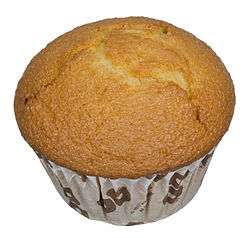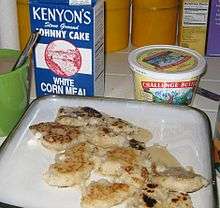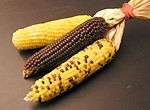Cornbread
Cornbread is any quick bread containing cornmeal, and a Native American cuisine. They are usually leavened by baking powder.[1]
.jpg) Skillet cornbread | |
| Alternative names | Corn pone |
|---|---|
| Type | Quick bread |
| Place of origin | United States |
| Region or state | Southeastern United States |
| Created by | Cherokee, Chickasaw, Choctaw, and Creek of the Southeastern United States, adapted by Southern Colonists |
| Serving temperature | Warm or room temperature |
| Main ingredients | Cornmeal, baking powder |
| Variations | Baked cornbread, Cracklin' bread, Corn pone, Hot water cornbread, Johnnycakes, Hushpuppies |
History

Native Americans had been using ground corn (maize) as food for thousands of years[2] before Europeans arrived in the New World.[3] European settlers, especially those who resided in the English Southern Colonies, learned the original recipes and processes for corn dishes from the Cherokee, Chickasaw, Choctaw, and Creek, and soon they devised recipes for using cornmeal in breads similar to those made of grains available in Europe. Cornbread has been called a "cornerstone" of the cuisine of the Southern United States.[4] Cornmeal is produced by grinding dry raw corn grains. A coarser meal (compare flour) made from corn is grits. Grits are produced by soaking raw corn grains in hot water containing calcium hydroxide (an alkaline salt), which loosens the grain hulls (bran) and increases the nutritional value of the product (by increasing available niacin and available amino acids). These are separated by washing and flotation in water, and the now softened slightly swelled grains are called hominy. Hominy, pozole in Mexican Spanish, also is ground into masa harina for arepas, tamales and tortillas. This ancient Native American technology has been named nixtamalization.[5] Besides cornbread, Native Americans used corn to make numerous other dishes from the familiar hominy grits to alcoholic beverages (such as Andean chicha). Cornbread was popular during the American Civil War because it was very cheap and could be made in many different forms—high-rising, fluffy loaves or simply fried (as unleavened pone, corn fritters, hoecakes, etc.).[1]
Types of cornbread
Cornbread is a popular item in Southern cooking enjoyed by many people for its texture and aroma. Cornbread can be baked, fried, or (rarely) steamed. Steamed cornbread is mushy, chewier, and more like cornmeal pudding than what most consider to be traditional cornbread. Cornbread can also be baked into corn cakes.
Baked cornbread
Cornbread is a common bread in United States cuisine, particularly associated with the South and Southwest, as well as being a traditional staple for populations where wheat flour was more expensive. Cornbread, especially leftovers, can be eaten as a breakfast. It is also widely eaten with barbecue and chili con carne. In parts of the southern and southwestern United States, cornbread, accompanied by pinto beans, has been a common lunch for many people. It is still a common side dish for many suppers, often served with butter. Cornbread crumbs are also used in some poultry stuffings; cornbread stuffing is particularly associated with Thanksgiving turkeys.
In the United States, northern and southern cornbread are different because they generally use different types of corn meal and varying degrees of sugar and eggs.[6] Southern cornbread has traditionally been made with little or no sugar and smaller amounts of flour (or no flour), with northern cornbread being sweeter and more cake-like. Southern cornbread traditionally used white cornmeal and buttermilk. Other ingredients such as pork rinds are sometimes used. Cornbread is occasionally crumbled and served with cold milk or clabber (buttermilk), similar to cold cereal. In Texas, Mexican influence has spawned a hearty cornbread made with fresh or creamed corn kernels and jalapeño peppers and topped with shredded cheese. Cornbread is typically eaten with molasses in the southern states and with butter and honey in the northern states of America.
Skillet-fried or skillet-baked cornbread (often simplified to cornbread or skillet bread) is a traditional staple in the rural United States, especially in the South. This involves heating bacon drippings, lard or other oil in a heavy, well-seasoned cast iron skillet in an oven, and then pouring a batter made from cornmeal, egg, and milk directly into the hot grease. The mixture is returned to the oven to bake into a large, crumbly and sometimes very moist cake with a crunchy crust. This bread tends to be dense and is usually served as an accompaniment rather than as a bread served as a regular course. In addition to the skillet method, such cornbread also may be made in sticks, muffins, or loaves.
A slightly different variety, cooked in a simple baking dish, is associated with northern U.S. cuisine. The batter for northern-style cornbread is very similar to and sometimes interchangeable with that of a corn muffin. A typical contemporary northern U.S. cornbread recipe contains half wheat flour, half cornmeal, milk or buttermilk, eggs, leavening agent, salt, and usually sugar, resulting in a bread that is somewhat lighter and sweeter than the traditional southern version.
Unlike fried variants of cornbread, baked cornbread is a quick bread that is dependent on an egg-based protein matrix for its structure (though the addition of wheat flour adds gluten to increase its cohesiveness). The baking process gelatinizes the starch in the cornmeal, but still often leaves some hard starch to give the finished product a distinctive sandiness not typical of breads made from other grains.
Cracklin' bread
A primarily Southern dish consisting of cornbread with pork cracklings inside. It can be prepared with any method but a skillet is most common as it allows for making the cornbread crispier.
Corn pone
Corn pone (sometimes referred to as "Indian pone") is a type of cornbread made from a thick, malleable cornmeal dough (which is usually egg-less and milk-less) and cooked in a specific type of iron pan over an open fire (such as a frontiersman would use), using butter, margarine, shortening, or cooking oil. Corn pones are a staple of Southern U.S. cuisine, and have been discussed or referenced by many American writers, including Mark Twain.[7]
In the Appalachian Mountains, cornbread baked in a round iron skillet, or in a cake pan of any shape, is still referred to as a "pone" of cornbread (as opposed to "hoe cakes", the term for cornbread fried in pancake style); and when biscuit dough (i.e., "biscuits" in the American sense of the word) is occasionally baked in one large cake rather than as separate biscuits, this is called a "biscuit pone".
The term "corn pone" is sometimes used derogatorily to refer to one who possesses certain rural, unsophisticated peculiarities ("he's a corn pone"), or as an adjective to describe particular rural, folksy or "hick" characteristics (e.g., "corn pone" humor). This pejorative term often is directed at persons from rural areas of the southern and midwestern United States. A character in the Lil' Abner comic strip, General Jubilation T Cornpone, was a mythical Civil War general from Dogpatch known for his retreats and imputed cowardice. President John F. Kennedy's staffers, who were mostly Northeastern Ivy League elites, openly mocked Texan Vice President Lyndon B. Johnson's rural speech patterns, referring to Johnson behind his back as 'Uncle Cornpone' or 'Rufus Cornpone'.[8]
Hot water cornbread
Cooked on a rangetop, one frying method involves pouring a small amount of liquid batter made with boiling water and self-rising cornmeal (cornmeal with soda or some other chemical leavener added) into a skillet of hot oil, and allowing the crust to turn golden and crunchy while the center of the batter cooks into a crumbly, mushy bread. These small (3-4" diameter) fried breads are soft and very rich. Sometimes, to ensure the consistency of the bread, a small amount of wheat flour is added to the batter. This type of cornbread is often known as "hot water" or "scald meal" cornbread and is unique to the American South.
Johnnycakes

Pouring a batter similar to that of skillet-fried cornbread, but slightly thinner, into hot grease atop a griddle or a skillet produces a pancake-like bread called a johnnycake. This type of cornbread is prevalent in New England, particularly in Rhode Island, and also in the American Midwest and the American South. It is reminiscent of the term hoecake, used in the American South for fried cornbread pancakes, which may date back to stories about some people on the frontier making cornbread patties on the blade of a hoe.
Hushpuppies
A thicker buttermilk-based batter that is deep-fried rather than pan-fried, forms the hushpuppy, a common accompaniment to fried fish and other seafood in the South. Hushpuppy recipes vary from state to state, some including onion seasoning, chopped onions, beer, or jalapeños. Fried properly, the hushpuppy will be moist and yellow or white on the inside, while crunchy and light to medium-dark golden brown on the outside.
See also
- Broa – Type of bread
- Corn dog – Deep-fried, corn-battered hot dog on a stick
- Cornmeal mush
- Jiffy mix
- List of American breads – Wikipedia list article
- List of maize dishes – Wikipedia list article
- List of quick breads – Wikipedia list article
- Makki di roti
- Mămăligă – Porridge made out of yellow maize flour, traditional in Romania
- Mchadi
- National Cornbread Festival – Annual festival in South Pittsburg, Tennessee, United States
- Polenta
- Proja – Balkan variant
- Corn pudding
- Soul food
- Spoonbread
Notes and references
- The acid-base reaction effected by baking powder mixed with the water-based liquids in the dough releases gas that causes the bread to rise during baking. Yeast is a living organism that releases gas under low-temperature conditions as it rises before baking. The yeast bodies continue rising so long as sufficient nutrients and proper warmth exist. During baking the temperature exceeds that which the yeast bodies can tolerate, and they die.
- Teosinte was known in Rio Balsas (Mexico) valley from 9000 BP and was introduced in what is now the United States by the Anasazis circa 1000 AD
- "Corn Bread". Indians.org. Retrieved 14 May 2012.
- "A Southern Commandment". PineStraw Magazine. 2016-10-28. Retrieved 2019-11-04.
- Dragonwagon, Crescent (2007). The Cornbread Gospels. Workman Publishing. ISBN 0-7611-1916-7.
- Cooks Illustrated Magazine, Baking Illustrated. Brookline, MA: America's Test Kitchen, 2004, ISBN 0-936184-75-2
- http://www.paulgraham.com/cornpone.html. Retrieved 7 November 2013
- The Passage of Power: The Years of Lyndon Johnson, pub. Deckle Edge, ISBN 0679405070, ISBN 978-0679405078
External links
- Indians.org History of cornbread
